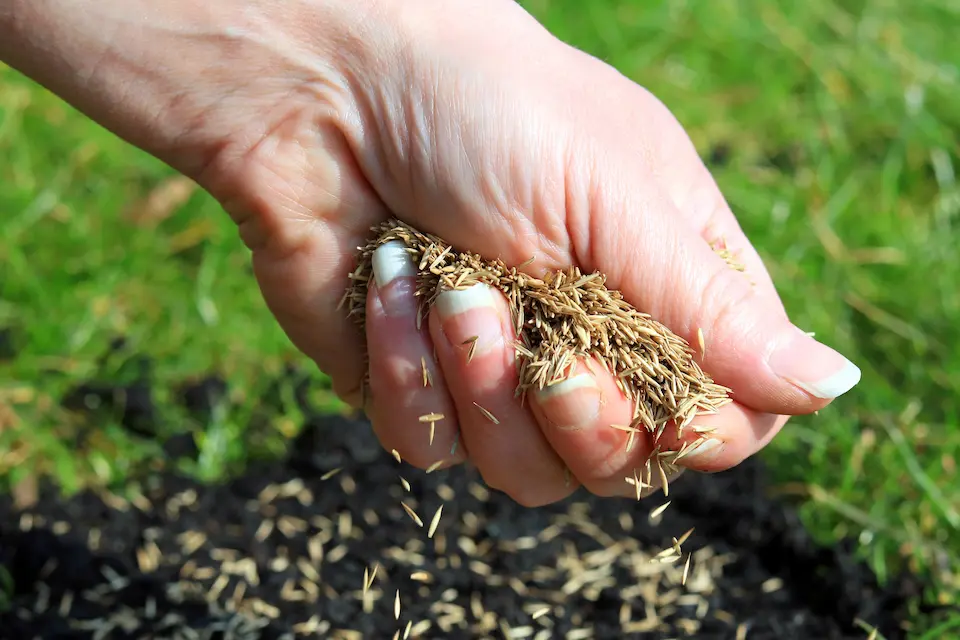Knowing the best time to plant grass seed in NC can be tricky for the average homeowner. If you don’t do it at the optimal time, you’re left with a lackluster lawn that costs you a lot of money.
That’s where we come in.
At FortSmith Landscaping, we want you to have the information you need to have a plush, green lawn 365 days a year. We’ve prepared some tips on when to plant grass seeds as well as a look at cool-season grasses and warm-season grasses because this will impact when you plant grass seeds. We’re also here to get the job done to make sure the right type of grass seed is planted at the best time for your lawn.
Let’s get start started!
Best Time to Plant Grass Seed in North Carolina

Since North Carolina has a wide range of climates, the time of year that the grass will have optimal growth will depend on where in the tar heel state you live. Warm soil temperatures are needed for the best seed growth. Generally, this is in the fall.
You also have to consider whether you’re planting warm-season grasses or cool-season grasses. Typically, warm-season grasses thrive best when they are grown during late spring and early summer while cool-season grass thrives in early fall.
Is it Ever Too Late to Plant Grass Seed in North Carolina?
Yes! Avoid seeding grasses in late winter. The frost in the soil slows down the growth. It can also severely damage the weed seeds.
Best Warm Season Grasses to Plant in North Carolina
When you plant warm-season grasses between mid-April and early June, you’re giving your seeds the best chance of taking advantage of the warmer temperatures. This combined with longer daylight hours will promote growth.
Here’s a quick tip…don’t plant too early in the spring. The late frosts can damage young grass seeds. Also don’t plant too late in the summer. Higher temperatures and possible drought conditions will hinder any growth.
Now that you know when to plant your warm-season grasses, let’s take a look at the different types of warm-season grasses.
Bermuda Grass
Bermuda grass is popular in North Carolina. For the best results, plant Bermuda grass seed between late April and early June. This gives it enough time to take advantage of the warm growing season.
This type of grass prefers full sunlight and well-draining soil. You want to have clean soil that is level for optimal planting. Also, be sure to water it regularly.
Centipede Grass
Centipede grass grows best in acidic soil because it has deep roots that allow it to take nutrients from the subsoil. It’s best for North Carolina’s piedmont and coastal plain areas and does not require much fertilizer. Centipede grass doesn’t hold up well against heavy foot traffic and is less resilient than other types of grass.
Zoysia Grass
On the flip side, Zoysia grass withstands foot traffic very well. It’s also drought-resistant, tolerates light shade, and withstands weeds. Zoysia grass does best when it is planted mid-to-late spring after the final frost, or during early summer.
Best Cool Season Grasses to Plant in North Carolina

If you’re thinking of planting cool-season grass, the best time is during the fall, between September and early October. This will allow the grass seed to germinate and get established before the winter. If you plant during this time, you also won’t be competing much with weeds since many die off as it starts to get colder.
If you miss the fall planting window, you can still plant cool-season grasses in early spring. Between late February and early April is best. But you may need to take more action to control weeds during this time.
Fescue Grass
Fescue grass does best when planted during the early fall, typically between August and early October. This allows the cool-season grass to establish itself before the winter. During this time, you can also take advantage of cooler temperatures and more rain. Tall fescue or fine fescue is generally best for North Carolina’s climate.
When you plant in the fall, the fescue grass has more of a chance to develop a strong root system before the summer heat and drought sets in. You could choose to plant fescue in early spring, but fall planting is typically best.
Perennial Ryegrass
If you’re thinking of planting perennial ryegrass, you’ll want to do this between August 15 and September 1st, especially if you’re growing it alongside Kentucky bluegrass. Perennial ryegrass is ideal for the mountainous regions of North Carolina.
Kentucky Bluegrass
Kentucky bluegrass is a great cool-season grass choice because it is heat and drought-resistant. You’ll want to plant this in early fall, between mid-August and mid-October, or during the spring.
FAQ About Planting Grass Seen in NC
What should I do before my lawn is seeded?
Before any seeding takes place, you want to clear the area of any rocks or debris that may interfere with seed growth. Rake the area to smooth the surface and eliminate any piles of dirt.
When should I aerate my lawn?
There is no cut-and-dry answer because it depends on the grass you grow. Early fall is good for aerating cool-season grass, while early spring is best for warm-season grass. The professionals at FortSmith Landscaping can take care of aerating your lawn and advise you about the best time to do it.
When should I mow my lawn?
Cool-season grasses should typically be cut to about 3-4 inches high. Warm-season grasses should be cut about 2-2.5 inches high. If you notice your grass getting taller, you’ll want to have it mowed.
Trust the Professionals at FortSmith Landscaping for All of Your Lawn Seeding Needs
When you need help planting grass seed or need help with any other lawn services, count on the professionals at FortSmith Landscaping to get the job done. We offer full lawn care services as well as landscape installation and seasonal cleanups in the Wake Forest area. Call us today at (919) 228-8495 or reach out to us for more information.
